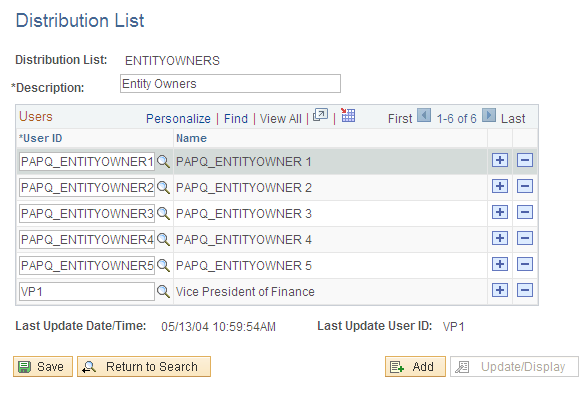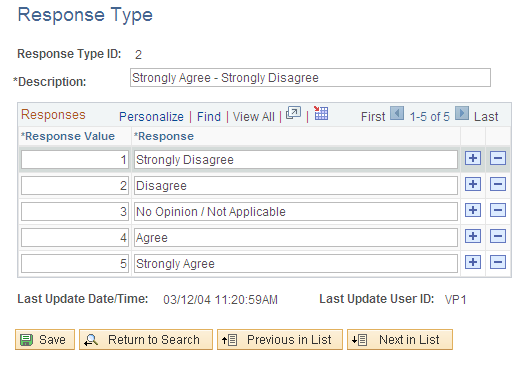Setting Up Survey Options
This section provides overviews of distribution lists, response types and values and discusses how to create distribution lists and establish response types.
|
Page Name |
Definition Name |
Usage |
|---|---|---|
|
EO_PE_SV_DSTRLST |
Create distribution lists to use for surveys. |
|
|
EO_PE_SV_RESPTYP |
Establish the responses for survey questions. |
Distribution lists enable you to define a group of user IDs that are related in some way, such as department managers, to use as survey recipients. When you establish a survey, you can use distribution lists to specify who will receive the survey. Use of distribution lists is optional, because you can also specify survey recipients by selecting individual user IDs.
Response types define the set of valid answers for a survey question. For example, an answer of either yes or no can be one response type. When you define the questions that are included on a survey, you specify their response type. This enables the system to list the possible valid answers to each question in the drop-down list box for generated surveys. When participants complete a survey, they select their response from this list. Several response types are delivered as system data; you can modify the delivered response types or create additional response types to suit a particular implementation.
Each response within a response type is associated with a numeric value. When you define a survey, you indicate what responses are expected or acceptable for each question. The system compares the expected response value with the actual responses to enable you to gauge whether responses match your expectations, and displays the information on the pages that you use to review the survey results.
For example, if the available responses and their corresponding values are 1 through 10, respectively, and 8 through 10 are acceptable, the expected response for a question would be ≥ 8. The Survey Summary page uses this range to indicate whether a response is expected. In the summary page, the expected column would display Yes for responses 8, 9, and 10 and No for the other responses.
This table lists the delivered response types:
|
Response Type ID |
Description |
Responses and Response Value (in Parentheses) |
|---|---|---|
|
1 |
Yes - No |
No (1), Yes (2) |
|
2 |
Strongly Agree - Strongly Disagree |
Strongly Disagree (1), Disagree (2), No Opinion / Not Applicable (3), Agree (4), Strongly Agree (5) |
|
3 |
Extremely Valuable - Irrelevant |
Irrelevant (1), Not Valuable (2), No Opinion / Not Applicable (3), Valuable (4), Extremely Valuable (5) |
|
4 |
Excellent - Poor |
Poor (1), Fair (2), No Opinion / Not Applicable (3), Good (4), Excellent (5) |
|
5 |
Scale 1-10 |
1, 2, 3, 4, 5, 6, 7, 8, 9, 10 The response values are equivalent to the responses. |
|
6 |
Most Likely - Not Likely |
Extremely Likely (10), Most Likely (20), Somewhat Likely (30), Unlikely (40), Not at all Likely (50) |
Access the Distribution List Page (Portal Administration, Survey, Distribution List).
The following example illustrates the Distribution List page. Access the Distribution List page (Portal Administration, Survey, Distribution List) as shown below.

Field or Control |
Description |
|---|---|
Distribution List and Description |
Enter a name and description for the distribution list. These appear in the selection list for the Distribution List field on the Survey Setup - Recipients page. |
User ID |
Insert rows in the Users grid, and specify the ID of each user who belongs to the distribution list. |
To specify the distribution lists for a survey, use the Survey Setup - Recipients page.
The following example illustrates the Response Type page. Access the Response Type page (Portal Administration, Survey, Response Type) as shown below.

Field or Control |
Description |
|---|---|
Response Type ID |
Enter an identifier for the response type. |
Description |
Enter a description for the response type. The description appears in the selection list for the Response Type field for a question when you define a survey by using the Survey Setup page. |
Responses
To specify the valid responses for this response type, add rows in the Response grid, and complete the following fields:
Field or Control |
Description |
|---|---|
Response Value |
Enter the numeric value to use for this response. The system uses this value when determining if a particular response is acceptable or expected. |
Response |
Enter the response. The system displays the response in the drop-down list box for the Answer field for a distributed survey for questions associated with this response type. |
When you establish questions during survey setup, you can only select response types that have defined responses. Response types that have been saved but have no responses defined do not appear in the selection list for the Response Type ID field on the Survey Setup page.